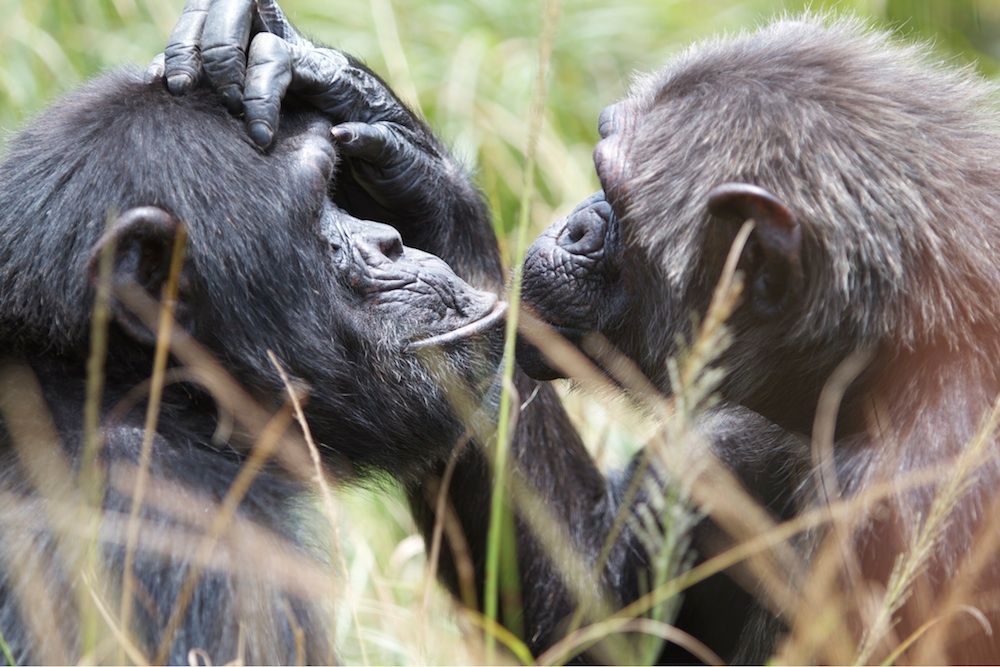Children Like Teamwork More Than Chimps Do

Chimpanzees and humans are fairly close cousins, evolutionarily speaking. But a new study finds they lack something that we have (besides written language and hairlessness): a desire to work together.
When all other things are equal, 3-year-old children prefer to do a task collaboratively rather than alone, while chimpanzees show no such preference, said study researcher Yvonne Rekers, a cognitive scientist at the Max Planck Institute for Evolutionary Anthropology in Germany.
"We expected that difference between human and chimpanzee cooperation, because we can see it nowadays," Rekers told LiveScience. "Humans collaborate in a larger variety of contexts and in more complex forms."
However, that leaves the question: Why these differences in cooperation? Cognitive abilities may be at the root of some of them, Rekers said, but motivation could matter as well.
Working together
To investigate the motivations of both species, the researchers chose a task that both groups would willingly undertake: pulling a rope to get a food reward. The children in the study got gummy frogs as their treat, while the chimpanzees got bananas.
Fifteen chimps and 24 children were introduced to the same experimental set-up: a room containing both a single end of rope and a doubled-over rope with two available ends. The 3-year-olds and the chimps were all taught that by pulling both ends of the doubled-over rope at the same time, they could draw a food-laden board toward them, delivering a batch of gummy frogs or bananas.
Sign up for the Live Science daily newsletter now
Get the world’s most fascinating discoveries delivered straight to your inbox.
Pulling the single rope would produce the identical food reward, but only with the help of another child or chimp in the room next door, who had to pull the opposite end of the rope at the same time. (The child or chimp acting as the potential partner in the experiment wasn't being tested; he or she had only the single end to pull. The potential partners were, however, highly motivated to pull that rope, because they too knew that a food reward would be coming their way.)
Cooperating kids
Despite the fact that the chimps got their food four to five seconds faster when they pulled the single end and worked with a partner than when they pulled both ends of the doubled rope by themselves, they were just as likely to choose the doubled rope, the researchers said. The chimps chose the single-ended rope 58 percent of the time, a number not significantly different than chance.
The 3-year-old children, by contrast, chose to pull the collaborative single rope in 78 percent of trials, even though it did not produce snacks any faster. [10 Things That Make Humans Special]
The children had all practiced the game beforehand and so knew how it worked. They, like the chimps, could see their potential partner through a opening between the two rooms. But to make their experience more like that of the chimps, the kids were encouraged not to speak during the experiment.
In order to keep all factors constant, a snack went to the cooperating child (the one not being tested) regardless of whether he or she was called upon to pull. That set-up, however, led Rekers and her colleagues to worry that perhaps the tested children were picking the collaborative work to prevent their partners from getting gummy frogs for doing nothing.
The researchers set up a second experiment with 12 new children in which the potential partner never received a reward — at least not within the sight of the tested child. The results were essentially unchanged, with 81 percent of kids choosing to work together. That finding suggested that the original result was not influenced by any desire to prevent freeloaders.
Rekers and her colleagues aren't sure whether this preference for cooperation is innate in humans or not, but one theory is that evolutionary pressures at some point nudged humans, but not chimps, into becoming cooperative foragers. The next step, Rekers said, is to study other primate species, such as bonobos.
She said she also plans to look into what children get out of working together.
"Is it just that they enjoy doing stuff together?" she said. "Or are they following other strategies or goals?"
The researchers reported their results today (Oct. 13) in the journal Current Biology.
You can follow Live Science senior writer Stephanie Pappas on Twitter @sipappas. Follow LiveScience for the latest in science news and discoveries on Twitter @livescience and on Facebook.

Stephanie Pappas is a contributing writer for Live Science, covering topics ranging from geoscience to archaeology to the human brain and behavior. She was previously a senior writer for Live Science but is now a freelancer based in Denver, Colorado, and regularly contributes to Scientific American and The Monitor, the monthly magazine of the American Psychological Association. Stephanie received a bachelor's degree in psychology from the University of South Carolina and a graduate certificate in science communication from the University of California, Santa Cruz.











